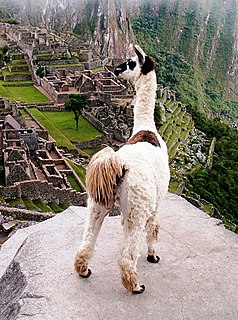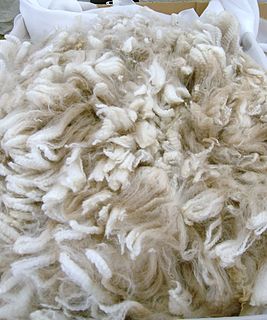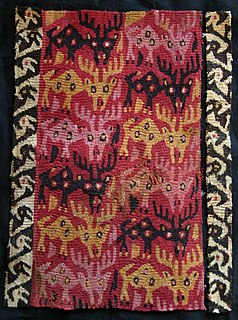| Look up wool in Wiktionary, the free dictionary. |
Wool is the textile fibre obtained from sheep.
Contents
Wool may also refer to:
| Look up wool in Wiktionary, the free dictionary. |
Wool is the textile fibre obtained from sheep.
Wool may also refer to:

The llama is a domesticated South American camelid, widely used as a meat and pack animal by Andean cultures since the Pre-Columbian era.

Wool is the textile fibre obtained from sheep and other animals, including cashmere and mohair from goats, qiviut from muskoxen, hide and fur clothing from bison, angora from rabbits, and other types of wool from camelids.

Textile is an umbrella term that includes various fiber-based materials, including fibers, yarns, filaments, threads, different fabric types, etc. At first, the word "textiles" only referred to woven fabrics. However, weaving is not the only manufacturing method, and many other methods were later developed to form textile structures based on their intended use. Knitting and non-woven are other popular types of fabric manufacturing. In the contemporary world, textiles satisfy the material needs for versatile applications, from simple daily clothing to bulletproof jackets, spacesuits, and doctor's gowns.

Yarn is a long continuous length of interlocked fibres, suitable for use in the production of textiles, sewing, crocheting, knitting, weaving, embroidery, or ropemaking. It can be made of a number of natural or synthetic materials, and comes in a variety of colors and thicknesses. Thread is a type of yarn intended for sewing by hand or machine. Modern manufactured sewing threads may be finished with wax or other lubricants to withstand the stresses involved in sewing. Embroidery threads are yarns specifically designed for needlework.

Mineral wool is any fibrous material formed by spinning or drawing molten mineral or rock materials such as slag and ceramics.
A silo is a structure for storing bulk materials.
Shift may refer to:

Lama is a genus containing four South American camelids, the wild guanaco and vicuña, and the domesticated llama and alpaca. Before the Spanish conquest of the Americas, llamas and alpacas were the only domesticated ungulates of the continent. They were kept not only for their value as beasts of burden, but also for their flesh, hides, and wool.

Steel wool, also known as iron wool, wire wool or wire sponge, is a bundle of very fine and flexible sharp-edged steel filaments. It was described as a new product in 1896. It is used as an abrasive in finishing and repair work for polishing wood or metal objects, cleaning household cookware, cleaning windows, and sanding surfaces.
Dust consists of fine, solid particles of matter borne in the air settling onto surfaces.

Polishing and buffing are finishing processes for smoothing a workpiece's surface using an abrasive and a work wheel or a leather strop. Technically polishing refers to processes that use an abrasive that is glued to the work wheel, while buffing uses a loose abrasive applied to the work wheel. Polishing is a more aggressive process while buffing is less harsh, which leads to a smoother, brighter finish. A common misconception is that a polished surface has a mirror bright finish, however most mirror bright finishes are actually buffed.
The manufacture of textiles is one of the oldest of human technologies. To make textiles, the first requirement is a source of fiber from which a yarn can be made, primarily by spinning. The yarn is processed by knitting or weaving, which turns yarn into cloth. The machine used for weaving is the loom. For decoration, the process of colouring yarn or the finished material is dyeing. For more information of the various steps, see textile manufacturing.

Animal fibers are natural fibers that consist largely of certain proteins. Examples include silk, hair/fur and feathers. The animal fibers used most commonly both in the manufacturing world as well as by the hand spinners are wool from domestic sheep and silk. Also very popular are alpaca fiber and mohair from Angora goats. Unusual fibers such as Angora wool from rabbits and Chiengora from dogs also exist, but are rarely used for mass production.

Alpaca fleece is the natural fiber harvested from an alpaca. There are two different types of alpaca fleece. The most common fleece type comes from a Huacaya. Huacaya fiber grows and looks similar to sheep wool in that the animal looks "fluffy". The second type of alpaca is Suri and makes up less than 10% of the South American alpaca population. Suri fiber is more similar to natural silk and hangs off the body in locks that have a dreadlock appearance. While both fibers can be used in the worsted milling process using light weight yarn or thread, Huacaya fiber can also be used in a woolen process and spun into various weight yarns. It is a soft, durable, luxurious and silky natural fiber.

The alpaca is a species of South American camelid mammal. It is similar to, and often confused with, the llama. However, alpacas are often noticeably smaller than llamas. The two animals are closely related and can successfully crossbreed. Both species are believed to have been domesticated from their wild relatives, the vicuña and guanaco. There are two breeds of alpaca: the Suri alpaca and the Huacaya alpaca.

Textile arts of indigenous peoples of the Americas are decorative, utilitarian, ceremonial, or conceptual artworks made from plant, animal, or synthetic fibers by native peoples of both North and South America.

Silo is a series of post-apocalyptic science fiction books by American writer Hugh Howey. The series started in 2011 with the short story "Wool", which was later published together with four sequel novellas as a novel with the same name. Along with Wool, the series consists of Shift, Dust, three short stories and Wool: The Graphic Novel.

Hugh C. Howey is an American writer, known best for the science fiction series Silo, part of which he published independently through Amazon.com's Kindle Direct Publishing system. Howey was raised in Monroe, North Carolina and before publishing his books, he worked as a book store clerk, yacht captain, roofer, and audio technician.

Charles Corydon Hall was an American businessman, chemist, engineer and industrialist. He developed a process of converting molten limestone into fibers that would become an insulation material. He initiated the rock wool insulation industry in America and is considered its progenitor. Rock wool was commonly used in refrigerator insulation.
Wool is an upcoming American science fiction streaming television series created and written by Graham Yost and directed by Morten Tyldum and based on the eponymous first book in the Silo series by author Hugh Howey. The series stars Rebecca Ferguson, who also executive produces the series, and is set to premiere on Apple TV+.